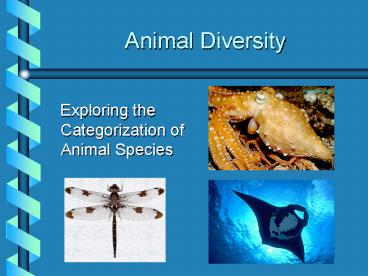Animal Diversity - PowerPoint PPT Presentation
1 / 26
Title: Animal Diversity
1
Animal Diversity
Exploring the Categorization of Animal Species
2
The Tree of Life The three domains of life
represent the earliest branches in evolutionary
history
3
Characteristics of Animals
- Eukaryotic
- Multicellular
- Heterotrophic
- Most are capable of sexual reproduction.
- Animal cells lack a cell wall.
- Motile during some stage of their life
- Respond to external stimuli as a result of nerve
and/or muscle action
4
Classification Scheme
Kingdom
Animalia
Animalia
Phylum
Chordata
Chordata
Mammalia
Mammalia
Class
Primates
Carnivora
Order
Felidae
Family
Hominidae
Homo
Felis
Genus
sapiens
Species
sylvestris
5
Ways to DistinguishBetween Animal Groups
6
Body symmetry
7
Phylum PoriferaSponges
- Asymmetrical
- Loosely structured collection of cells
- Cell specialization
- Lack tissues
- Non-motile as adults
- Filter feeders
8
Phylum CnidariaCoral, Hydra, Anemones and
Jellyfish
- Radial symmetry
- Cells organized into two tissue layers
- Lack true organs
- Nerve network and contractile tissue
- Body plans Polyp- attached Medusa- motile
- Mouth and anus are same opening
- Asexual and sexual reproduction
9
Body Cavities
Coelom body cavity lined on all sides
by a layer of mesodermal cells
10
Phylum PlatyhelminthesTapeworms, Flukes ,
Flatworms
- Bilateral symmetry
- Acoelomate
- Three tissue layers
- Excretory and Reproductive Organs
- Move by use of nerve cells, ganglia
- Many are free-living
- some are parasitic
11
Phylum NematodaRoundworms
- Bilateral symmetry
- Pseudocoelomate
- Three tissue layers
- Tubular gastrovascular cavity two openings
- Ganglionic Brain
- Gas exchange by diffusion
- A few species are parasitic
12
Phylum Annelida Segmented Worms
- Bilateral symmetry
- Coelomate, fluid filled cavity allows movement
- Three tissue layers
- Segmented body
- Closed circulatory system 5 pairs of hearts
- Excretory organs nephridia
- Digestive system with specialized areas
- Segmented muscles for movement
13
Phylum Mollusca
- Bilateral symmetry
- Coelomate
- Three tissue layers
- Soft body in a calcium containing shell
- 3-chambered heart, blood vessels
- Ciliated digestive tract
- Excretory organs nephridia
- Head-foot has sensory and motor organs
- Gills for oxygen absorption
- Tooth-bearing strap radula
14
Classes of Phylum Mollusca
- Class Bivalvia
- clams, mussels, oysters, scallops
- Class Gastropoda
- snails, slugs
- Class Cephalopoda
- squid, octopus
- Class Polyplacophora
- chitons (ancestral)
- eight plates on back
15
Phylum Arthropoda
- Bilateral symmetry
- Coelomate
- Three tissue layers
- Distinct body regions head, thorax, abdomen
- joint-footed
- Exoskeleton, moved at joints by muscles
- Open circulatory system
- Complex nervous system, compound eye
- Efficient gas exchange system
16
Classes of Phylum Arthropoda
- Class Arachnida
- spiders, ticks, scorpions
- Class Crustacea
- crabs, lobsters, shrimp
- Class Insecta
- insects
- Class Diplopoda
- millipedes2 pairs of legs/segment
- Class Chilopoda
- centipedes1 pair of legs/segment
- Class Meristomata
- horseshoe crabs
17
Protostome mouth forms first during embryonic
development Deuterostome anus forms first
and then mouth forms
18
Phylum Echinodermata
- Radial symmetry, 5-part body plan
- Coelomate
- Deuterostome
- Three tissue layers
- Spiny Skin
- Modified coelom forms a water vascular system to
move tube feet - Nervous system central nerve ring with branches
19
Classes of Phylum Echinodermata
- Class Asteroidea
- sea stars
- Class Echinoidea
- sea urchins, sand dollars
- Class Holothuroidea
- sea cucumbers
- Class Ophiuroidea
- brittle stars
20
Phylum Chordata
- Bilateral symmetry
- Coelomate
- Deuterostome
- Three tissue layers
- Four common features
- Notochord
- Dorsal, hollow nerve cord
- Pharyngeal gill slits
- Post-anal tail
21
Sub-Phylum Vertebrata
- Notochord replaced by vertebral column
- Endoskeleton
- Development of brain
- Closed circulatory system,heart with 2 or more
chambers - Use of gills, skin or lungs to obtain oxygen
- waste removal by kidneys
- Separate sexes, internal or external fertilization
22
Classes of Sub-Phylum Vertebrata
- Class Agnatha
- jawless fishes
- Class Condrichhthyes
- cartilaginous fish
- Class Osteichthyes
- bony fish
23
Classes of Sub-Phylum Vertebrata
- Class Amphibia
- frogs, toads, salamanders
- Class Aves
- birds
- Class Reptilia
- lizards, snakes, turtles, alligators
24
Classes of Sub-Phylum Vertebrata
- Class Mammalia
- most bear live young
- milk from mammary glands
- hair
- endotherms
- monotremes egg laying
- platypus
- marsupials
- kangaroo
- placentals
- bat, rabbit, dog, cattle, whale, human
25
Worksheet
- Complete pages 125-126 from lab manual
- Record your answer and reasoning for any 8
specimens, making sure to write the answer on the
line that matches the specimen number - Be sure your instructor checks your completed
worksheet before you leave the lab.
26
CLEAN UP!
- Leave animal specimens and their skeletons in
orderly arrays - Thank you!































